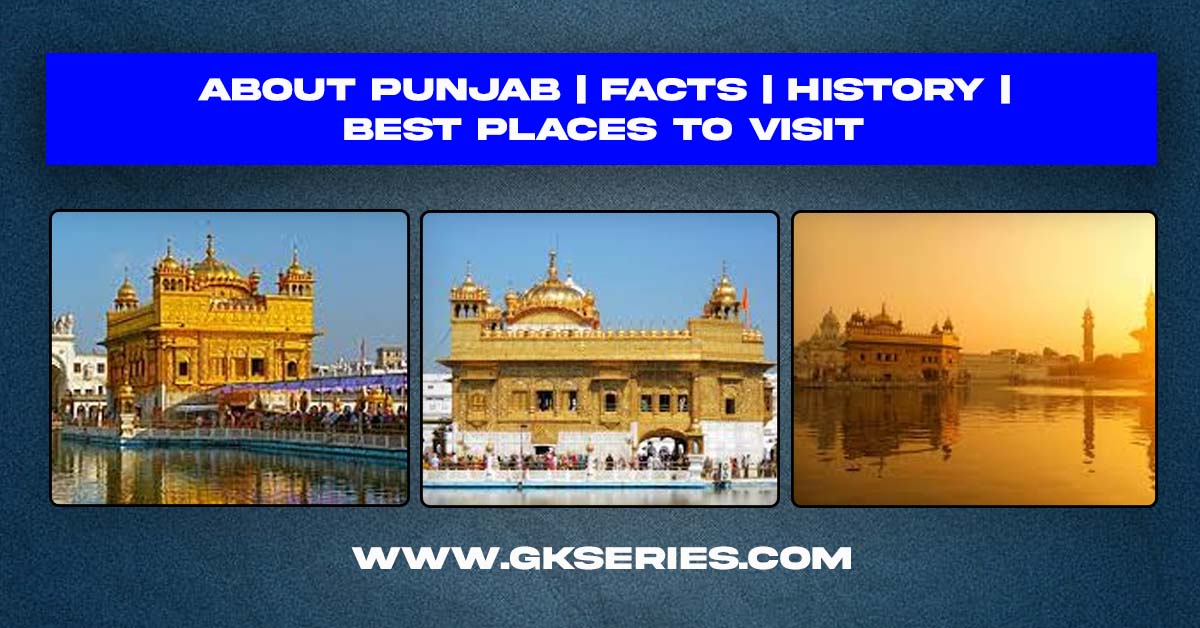
In this article, we provide comprehensive information about the geography, history, population, and top tourist destinations of Punjab. Punjab, often referred to as the “Land of Five Rivers,” is a vibrant and culturally rich state in northern India. Known for its historical significance, fertile lands, and spirited people, Punjab holds a special place in the heart of India. It is celebrated for its rich heritage, warm hospitality, and dynamic culture.
| About: | Punjab is a state in northwestern India. Forming part of the larger Punjab region of the Indian subcontinent, the state is bordered by the Indian states of Himachal Pradesh to the north and northeast, Haryana to the south and southeast, and Rajasthan to the southwest; by the Indian union territories of Jammu and Kashmir to the north and Chandigarh to the east. It shares an international border with Punjab, a province of Pakistan to the west. Punjab has achieved significant economic growth since Independence, despite the challenges it faced in 1947. The state accounts for nearly two-thirds of the total food grain production and a third of the country’s milk output. As the leading wheat producer, Punjab plays a crucial role in ensuring national food security. The Green Revolution, a major agricultural initiative, has been actively embraced by the people of Punjab. Although Punjabis make up less than 2.5% of India’s population, they are among the most prosperous communities in the country, with a per capita income that is double the national average. The most widely spoken and official language of the state is Punjabi, which is written in the Gurmukhi script. The primary ethnic group is Punjabis, with Sikhs (57.7%) and Hindus (38.5%) being the major religious communities. Chandigarh serves as the state capital and is also a union territory, sharing its status as the capital with the neighboring state of Haryana. Punjab is traversed by three tributaries of the Indus River: the Sutlej, Beas, and Ravi. According to 2011 Census of India, the total Population of Punjab is 2,77,43,338. The decadal change i.e. increase in population from 2001 to 2011 is 13.89%. |
| History: | Reference of ‘Punjab’ can also be found in volume one of “Ain-e-Akbari”, written by Abul Fazal, where ‘Punjab’ describes the territory that can be divided into provinces of Lahore and Multan. Similarly, in the second volume of Ain-e-Akbari, the title of a chapter includes the word ‘Panjnad’ in it. However, the first mentioning of Sanskrit equivalent of ‘Punjab’ occurs in the great epic, the Mahabharata, where it is described as pancha-nada, which means ‘country of five rivers’. The Mughal King Jahangir also mentions the word Panjab in ‘Tuzk-i-Janhageeri’, derived from Persian and introduced by the Turkic conquerors of India, literally means “five” (panj) “waters” (ab), i.e., the Land of Five Rivers, referring to the five rivers which go through it. It was because of this that it was made the granary of British India. The Punjabi language has its roots in the Indo-European family, which also includes Persian and Latin. Known for its ethnic and religious diversity, this region is the birthplace of several significant religious movements, including Sikhism, Buddhism, and various Sufi schools of Islam. The Indian State of Punjab was established in 1947, following the partition of India, which divided the former Raj province of Punjab between India and Pakistan. The predominantly Muslim western section became Pakistan’s Punjab Province, while the mainly Sikh eastern section became India’s Punjab state. This partition resulted in widespread displacement and intercommunal violence, as many Sikhs and Hindus resided in the west, and many Muslims in the east. Additionally, several small Punjabi princely states, such as Patiala, were incorporated into Indian Punjab. In 1950, two distinct states were formed; Punjab encompassed the former Raj province, while the princely states of Patiala, Nabha, Jind, Kapurthala, Malerkotla, Faridkot, and Kalsia were merged into a new entity called the Patiala and East Punjab States Union (PEPSU). Himachal Pradesh was created as a union territory from various princely states and the Kangra District. In 1956, PEPSU was integrated into Punjab state, and several northern districts of Punjab in the Himalayas were transferred to Himachal Pradesh. |
| Geography: | The total area of the state is 50,362 square kilometers (19,445 square miles), with the cultivable area being under assured irrigation. Its average elevation is 300 meters (980 ft) above sea level, with a range from 180 meters (590 ft) in the southwest to more than 500 meters (1,600 ft) around the northeast border. The state has a balanced amalgamation of heat in summer, rain in monsoon and cold in winter. Each of the three seasons is so distinctly defined that you can appreciate them individually. Punjab experiences both summer and winter in their most intense forms. It also receives significant rainfall, contributing to the state’s fertility. Areas near the foothills of the Himalayas experience heavy rainfall, while regions farther away from the hills see less rain and higher temperatures. |
| Country : | India |
| Region: | North India |
| Capital: | Chandigarh |
| Largest city: | Ludhiana |
| Language: | Punjabi |
| Population: | 27,743,338 (2011) |
| Literacy rate: | 75.84% (2011) |
| Major Attractions to Visit: | Golden Temple (Amritsar) Jallianwala Bagh (Amritsar) Wagah Border (Amritsar) Partition Museum (Amritsar) Durgiana Temple (Amritsar) Anandpur Sahib (Rupnagar) Virasat-e-Khalsa (Anandpur Sahib) Harike Wetland and Bird Sanctuary (Ferozepur) Sheesh Mahal (Patiala) Qila Mubarak Complex (Patiala) Baradari Garden (Patiala) Rock Garden (Chandigarh) Sukhna Lake (Chandigarh) Rose Garden (Chandigarh) Punjab Agricultural University Museum (Ludhiana) Phillaur Fort (Ludhiana) Rangla Punjab Haveli (Jalandhar) Wonderland Theme Park (Jalandhar) Kanjli Wetlands (Kapurthala) Pushpa Gujral Science City (Kapurthala) Mukteshwar Mahadev Temple (Pathankot) Bathinda Fort (Bathinda) Damdama Sahib (Bathinda) Ranjit Sagar Dam (Pathankot) Hussainiwala Border and Memorial (Ferozepur) |





